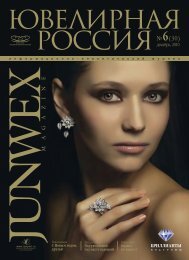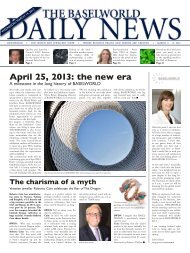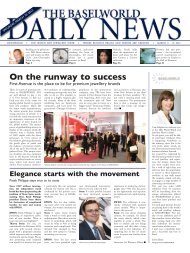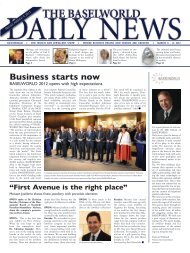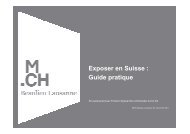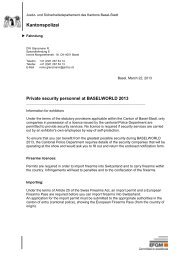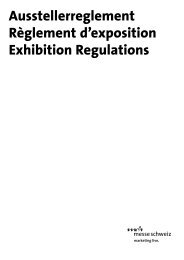WatchTime - August 2012
WatchTime - August 2012
WatchTime - August 2012
Create successful ePaper yourself
Turn your PDF publications into a flip-book with our unique Google optimized e-Paper software.
PROFILE<br />
TAG Heuer’s Jean-Christophe Babin<br />
just five years, thanks largely to Babin’s<br />
vertical integration.<br />
MUCH OF HIS tenure has been tougher<br />
than he expected. For one thing, the competition<br />
is worse: there are more brands in<br />
the watch business than in others Babin<br />
has seen; some 200 active ones in Switzerland<br />
alone. “Before Christmas, you can<br />
count up to 40 brands advertising in a single<br />
[general interest] magazine. You won’t<br />
find any other product like that,” he says.<br />
One reason, he believes, is that the<br />
watch business has been very easy to get<br />
into. “Until recently anyone could launch<br />
a watch brand with a few million dollars<br />
because you could subcontract everything,”<br />
he says. You came up with a good<br />
idea, found the right third-party suppliers,<br />
and, if you had good relationships with<br />
the trade, you were in.<br />
Babin with TAG-sponsored actress Uma Thurman in 2006 ...<br />
80 <strong>WatchTime</strong> <strong>August</strong> <strong>2012</strong><br />
Distinguishing his brand from the others<br />
has also been harder than he thought it<br />
would be. A watch has so many mandatory<br />
components − a dial, hands, indices –<br />
that there isn’t much room for improvisation,<br />
he believes. “The room for differentiating<br />
is very small and the constraints you<br />
have are many. I thought, naively, when<br />
entering the business, that it would be<br />
much easier.”<br />
Furthermore, the market requires constant<br />
technological innovation, a taxing<br />
proposition and, he believes, a paradox<br />
given that a luxury watch is supposed to<br />
be something one wears for decades.<br />
He was also surprised by the speed with<br />
which watch brands rise and fall. “There<br />
are brands that were virtually nonexistent<br />
in the early 2000s, when I joined the company,<br />
and today they’re super stars,” he<br />
says. Hublot, also owned by LVMH, and<br />
the fashion brand Ice Watch, founded only<br />
five years ago, are just two examples of apparent<br />
overnight sensations. “Ice Watch did<br />
3 million pieces last year,” Babin says. The<br />
opposite is also true: “Some brands were<br />
extremely powerful and today they are dying.<br />
A strong brand can become a weak<br />
brand in three years. In consumer goods it<br />
takes ages.”<br />
Babin has had a few major bloopers. In<br />
2002, he introduced several models with<br />
gold cases, believing that because LVMH<br />
was a luxury-goods company, TAG should<br />
sell luxurious watches. Consumers didn’t<br />
agree. “The brand image and reputation<br />
were probably not strong enough to sell<br />
gold. In a gold watch, the main cost is the<br />
gold, not so much the movement or the labor.<br />
So the more gold you use, the closer<br />
you are to Rolex in terms of price. And this<br />
works if your image somehow competes<br />
with Rolex. If your image is still too far<br />
away, which was the case in the early<br />
2000s, obviously it’s hard to sell gold. You<br />
can compete [in the gold-watch market] only<br />
when you have achieved a certain status<br />
level. Now we can sell gold, not as much as<br />
Rolex, but we are credible.”<br />
He stumbled again when he opened two<br />
ill-fated stores. One was in New York’s So-<br />
Ho neighborhood. “While visiting New<br />
York I discovered that there were no watch<br />
retailers in SoHo. It was very active and<br />
lively there on the weekends because the<br />
Madison Avenue stores were closed on Sundays.<br />
I thought that because there were no<br />
watch retailers there, that we would make a<br />
lot of money,” he recalls. “But the reason<br />
there were no watch retailers there was that<br />
there was no watch business,” he says with<br />
a laugh. “The boutique proved to be a disaster.”<br />
Babin closed the store after two and<br />
a half years and took a massive write-off.<br />
He made a similarly costly mistake in London,<br />
opening a store in the wrong location.<br />
Eventually, Babin got the hang of retail. By<br />
the end of this year, TAG will have 60 boutiques<br />
worldwide, and 90 percent of them<br />
are doing well, he says.<br />
HE HAS MORE to learn. One question is<br />
how to cope with a huge problem facing<br />
nearly all of the Swiss watch industry: the<br />
Swatch Group’s cutbacks in sales of finished<br />
movements and movement components.



